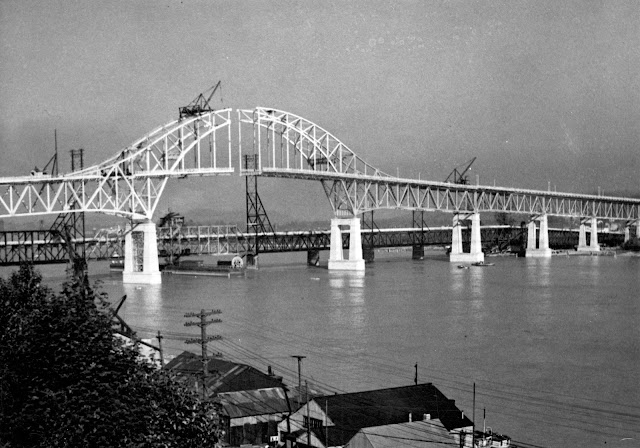2024: (Satellite, just upstream of the railroad bridge.)
 |
| Street View, Jul 2022 |
 |
| Ironworkers Local 97 posted A true work of art. We're proud to be bringing this project to life for all of you. |
The legs of the tower are peaking out above the barge in the foreground.
 |
| Street View, Jul 2022 |
The lanes on the old bridge look narrow, and there is no pedestrian crossing.
 |
| Street View, May 2023 |
 |
| PattulloBridgeReplacement "$1.377 billion project" |
 |
| HistoricBridges, Source: Vancouver Archives It is 4,007.0 Feet (1221.3 Meters) long with a main span of 438.0 Feet (133.5 Meters). "The Pattullo Bridge is an example of one of the more gracefully beautiful bridge types conceived, a steel trussed through arch." [Note that the arch can be built without falsework.] |
Construction started in 2020. [aecon]
"The new bridge will be built to allow for potential future expansion to six lanes." [PattulloBridgeReplacement_design] This webpage shows the selected design option.
HistoricBridges has a downloadable archive of info about the new bridge. I looked at the file "Options Considered but not Pursued." They only considered a cable-stayed bridge design. The choices were about where to put the bridge and how to connect it to the existing streets.
Kiewit Corporation posted three photos with the comment:
Have you spotted Kiewit’s D.B. Patrick helping out around the new Pattullo Bridge site?The D.B. Patrick, a 303-ton heavy lift pile driver, is currently supporting the Pattullo Bridge Replacement Project in British Columbia, specifically assisting with the installation of steel girders for the north approach. This new four-lane cable-stayed bridge will improve connections between New Westminster and Surrey, providing wider lanes for both passenger and commercial vehicles, dedicated walking and cycling lanes, and enhanced safety features.We are supporting Fraser Crossing Partners, a joint venture between ACCIONA and Aecon Group Inc., by contributing our D.B. Patrick, staff and craft employees to this significant infrastructure development.
.jpg) |
| 1 |
 |
| 2 |
 |
| 3 |










































